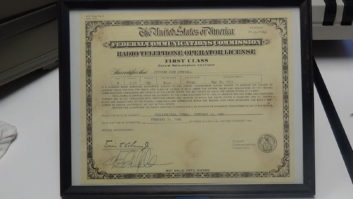UAVS VS. MODEL AIRPLANES
Read the article about “drones” in the June 3 edition.
I have been flying model airplanes since the age of 7, joined the Academy of Model Aeronautics in 1986, and began to compete in radio control aircraft precision aerobatics around 1990. Won several competitions and plenty of bling for the “me wall.” That was all back when you had to build your own models, and you really had to learn how to fly.


Paul Shinn’s passion for flying model airplanes started at an early age and continues today. When the lightweight digital cameras came around in the early 2000s, I fitted one to a large radio control airplane for the purpose of doing tower light and antenna inspections on FM towers. Using a very lightweight model airplane with a low wing loading, I was able to slow the plane down enough to get very detailed (at the time) images of tower structures, antennas, etc. With a steady headwind, I could nearly hover the model and get closer shots of specific details. This required tremendous flying skill to keep from damaging the models or the objects being observed. I never had an incident.
A number of years ago, the technology for FPV (First Person Point of View) became affordable and light enough to attach to a larger electric powered model airplane. In recent years, we have seen a tremendous rise in use of multi-rotor radio controlled aircraft, what people now call simply “drones.” The multi-rotor radio control aircraft are usually equipped with on-board stabilization, GPS, etc. to make them easily flown by people with little to no skill in piloting radio controlled aircraft. This has paved the way for nearly anyone to fly one with success.
Using radio-controlled models to inspect towers, etc. is not new. It’s just now starting to get a lot of press because they are affordable and anybody can fly one. The AMA has been pushing the FAA to not impose restrictions on model aircraft, and there is still no real resolution to the issue of the federal government lumping all model aircraft in with the drones. As more and more people buy and fly multi-rotor aircraft, and do so irresponsibly, it creates a real problem with the way the public sees “drones” and their usefulness. It is my sincere hope that all multi-rotor aircraft pilots would do so responsibly and safely. Especially when it comes to flying over people or property, like broadcast facilities.
Meanwhile, there’s nothing as relaxing as sitting back and hunting for thermals with a radio-controlled glider on a beautiful weekend. No multi-rotor “drone” can match that.
Paul Shinn
Chief Engineer
KVML(AM)/KKBN(FM)/KZSQ(FM)
Clarke Broadcasting
Sonora, Calif.
DEBATING CLASS A
I would like to defend Class A stations and even suggest that power increases should be granted to overcome a lot of the electronic hash that seems to impede clear reception. (“Littlejohn: Retain Class A Protections,” July 1.)
I grew up in northern Michigan, and listening to the big kilowatt factories out of Chicago, New York and Boston was a joyful nighttime ritual. The quality of the programming was superior in content and diversity. But most of all it was dependable. Traveling by automobile was also enhanced by powerful stations that you could receive, even if you had long distances to cover requiring several hours behind the wheel.
The state of local AM radio is none of that. Most of these local stations appear to be automated, with no operator and no one who can respond when the audio is dropped and only an unmodulated carrier is left.
There have been cases when the automation got stuck and played a five-minute stop set of commercials over and over for more than an hour. Another time the local sequence was out of sync with the satellite feed and the two audio streams played on top of each other.
The worst problem was a brush fire that had erupted on a Saturday afternoon. The sky had turned red with smoke, breathing was difficult and the situation became increasingly severe over the course of several hours. The two local news/talk stations were plugged into satellite programing, and the three local TV stations seemed to be unaware and didn’t display even a news crawler on the screen. When you call the stations, all you get is an answering machine.
Another instance of non-service from local radio was an evening when we were plunged into the dark at about 8 p.m. Local radio stations were silent; evidently they have no backup generators. I didn’t have a battery-operated TV, so I didn’t know their status. I monitored the ham radio repeaters (they do have backup power) and local hams were able to get reports from other operators and determined within 45 minutes that a two-county area of central California was affected. In another 30 minutes, they relayed information from PGE with an estimate of a few hours before power could be restored. It was two and a half hours before KNX broke in with a bulletin about the situation. Thank goodness for a Class A in Los Angeles. These stations are needed. Let’s keep them. Let’s increase their power.
I remember the words of an FCC chairman who famously (maybe infamously) said that he would keep issuing licenses “until the last station couldn’t stay on the air.” Well, we have come to a point where there seems to be dozens of stations that are on that brink and have cut back staff and engineering budgets and their only contribution to broadcasting is cluttering up the spectrum and causing interference to each other, besides competing for the available advertising revenue.
Jan Lipski
Owner
Jay Alexander Productions/Consulting
Lompoc, Calif.
Upon reading the interview with Mr. Jeff Littlejohn of iHeartMedia, I just shook my head in disappointment. Of course, the EVP of engineering at iHeartMedia is going to argue against any compromise to his group’s 17 Class A signals coverage. That is a foregone conclusion.
I differ with Mr. Littlejohn, though, as I believe that what is good for the whole of AM radio stations in the USA isn’t necessarily good for all radio stations, especially the Class As.
Many of today’s 1, 5 and 10 kW local AM stations are near extinction as the out-of-town or out-of-state Class A stations’ signals take away local listeners. The ability of large radio groups to afford syndicated programming that steals away local listeners, essentially takes money out of the pocket of local mom and pop stations.
For some stations, the ability to have a 24/7/365 signal can mean the difference between prosperity and extinction. However, these stations are forced to operate with extremely low power or no night signal just to protect the skywave of a station nearly 1,000 miles away. I can only imagine the local events, sports games, weather and emergency warnings that could benefit a local audience, if the protection of Class A stations were no longer an issue. (After all, in some markets you can hear Rush Limbaugh on several different spots on the dial simultaneously.)
I say that 10 kW should be the nighttime maximum for any AM station, and protections should be revised for the benefit of the local stations that have suffered for the past several decades.
Dave Dybas
Owner/Engineer
Sparks Broadcast Service
Buffalo Grove, Ill.

LPFM SUGGESTIONS
They may be small, but LPFMs are a part of the broadcast community. I would urge every one of them to keep up with what is going on in the broadcast industry. A good start is to subscribe to all the broadcast-oriented publications they can get there hands on, especially this one.
There is a lot of great information available, as well as a heads up on whatever new the FCC is getting ready to do. For any broadcaster (including LPFMs), many of these subscriptions are free. They should also check out the FCC Daily Digest on a regular basis. It is easy to subscribe to from the FCC’s website. It will arrive in your email inbox Monday through Friday. Specifically, you should read the “Broadcast Applications” and “Broadcast Actions” sections every day. It is the only way you will find out who is building what in your market, before it is too late.
I also suggest that LPFMs join their state broadcasters association and attend the meetings. Most have special rates for LPFMs. Attending these conventions is a great way to network with other broadcasters. You’ll find that most LPFMs have a lot in common with many mom and pop 1,000-watt AM stations. Once they meet you and find out that you are not out to kidnap their first-born, many of these broadcasters can become great friends and may even help you. Stranger things have happened.
If there is a Society of Broadcast Engineers chapter in your area, make an attempt to attend at least one of their meetings and introduce yourself. Better yet, join SBE and become a regular — it is where all the engineers hang out. Once they discover that you are serious about being a responsible broadcaster, you will find that many of them are more than willing to help you out. A lot of these guys even know where the free equipment is located …
Chuck Conrad
KZQX(FM), KDOK(AM) & KEBE(AM) Radio
Jacksonville, Texas
RADIO’S STEPCHILD
With all due respect to T. Scott Bailey, president/GM of WMRO/Gallatin, Tenn. (“Community AM Was Here First,” July 15 issue):
I am one of those LPFM operators you are railing against indirectly. Forgive me for being defensive. But we did not create nor relax the rules where the AM band has been allowed to disintegrate into being almost unlistenable. It’s also unfair that you have a FM translator but since you cannot be the licensee, you can’t afford the translator. Again, not LPFM’s fault.
REC Networks does not need me to defend them, but they are not advocating a commercial service. It has been shown that LPFMs are no threat to commercial radio stations in any case. I am in favor of very relaxed rules and penalties regarding enhanced underwriting for LPFMs who cannot afford full power NCE level fines — and even full power stations struggle with the rules regarding underwriting!
And though the proposed power increase to 250 watts sounds impressive, you of all people should know that it does not triple nor even double our coverage area, which is skimpy to begin with, not to mention (for those of us in more crowded areas) fighting co-channel interference. It is generally agreed that the proposed power increase will help with signal strength within our existing contours, and maybe an additional mile more. That’s all.
And remember that it is LPFM, not AM, that is the stepchild of radio broadcasting. We have no interference protection, nor (as a secondary service) protection from full-power stations who may decide to take over our channel. So forgive me again if I’m only partially sympathetic to your ranting. The odds against any LPFM are way bigger than those against your station or any well-run full-power station.
BJ Mora
GraceRadio/KGCE(LP)
Grace Church
Modesto, Calif.









